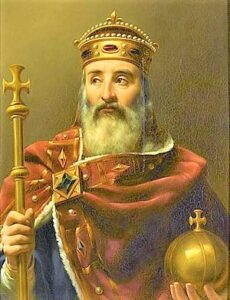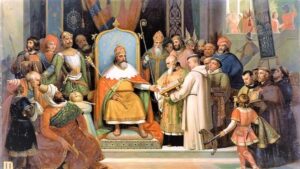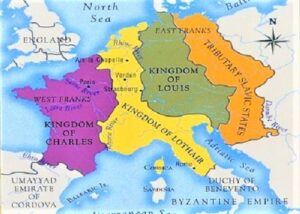Charlemagne (2 April 748 – 28 January 814) is also known as Charles the Great or Charles I, was king of the Franks from 768, the king of the Lombards from 774, Emperor of the Carolingian dynasty, and the Emperor of the Romans from 800 until his death.
During his reign, he conquered Italy and was crowned Emperor Augustus by Pope Leo III on December 25, 800, with some historians seeing this as an attempt to revive the Western Roman Empire. The Carolingian Empire was in Europe, in a sense, a rival state to the Eastern Roman Empire, with its capital at Constantinople (also called the Byzantine Empire ).
Charlemagne is part of the Carolingian dynasty and is sometimes considered the founding father of both France and Germany. Some historians consider him the father of Europe. He was the first ruler of an empire in Western Europe since the collapse of the Roman Empire with its capital in Rome.

Quick Facts Of Charlemagne
- Born: 2, April, 748, in the Frankish Kingdom
- Also known as: Charles the Great or Charles I
- Spouses: Desiderata (m. c. 770; annulled 771), Hildegard of Vinzgouw (m. 771; d. 783), Fastrada (m. c. 783; d. 794), and Luitgard (m. c. 794; d. 800)
- Dynasty: Carolingian
- Father: Pepin the Short
- Mother: Bertrada of Laon
- Religion: Roman Catholicism
- Died: 28 January 814 (aged 65, 66, or 71), Aachen, Francia
- Burial: Aachen Cathedral
- Quotes: Right action is better than knowledge; but in order to do what is right, we must know what is right. – Charlemagne
Rise of the Empire
The monarchy of Charlemagne at the end of his reign covered an area of over one million square kilometers. At its peak, Charlemagne’s empire encompassed the territories of today’s states:
- France
- Belgium
- The Netherlands
- Austria
- Switzerland
- West Germany
- Northern Italy
- And the Northeast of Spain and the Balearic Islands.
Administering such a huge country was difficult. The division into lands and counties, which was still functioning under the Merovingians, was maintained, but next to it counties were introduced as smaller units of territorial administration, which were subordinated to officials appointed and dismissed by the ruler.
In the borderlands of the monarchy, marches were organized, led by margraves with broad military powers. These marches (Danish, Friulska, Spanish, Breton, Pannonian) were a military barrier blocking pagan peoples and Muslims from entering the lands of the Carolingian state.
His military successes made Charles the most powerful ruler of Western Europe. The empire he built, inhabited by the Romanesque and Germanic people, economically and socially diverse, was in practice a patchwork of many conquered tribes and lands in which neither the sense of separateness nor the longing for independence died out.
Conscious of this, the ruler tried to unify the empire by introducing, inter alia, uniform Frankish law, a new administrative division, or a reformed monetary system based on the silver denar. The most lasting foundation of unity, however, was the strong power of the monarch and the community of Christian faith and culture.
King of the Franks

With the death of his father, Pepin the Short, Charlemagne became, in 768, king of the Franks, governing together with his brother Carloman I, whose early death in 771, ended the existing rivalry between the brothers.
During his long reign, Charlemagne fought against all who might threaten him. His well-organized forces, his military strength guaranteed him the domination of most of Europe. In 772, the defensive operation against the Saxons turned into a prolonged and bloody war that only ended with the total submission of that people, in 804.
In 774, the Lombard king Desiderio demanded that Pope Adrian I crown one of his sons as heir to the Frankish throne. The pope did not agree and had his territories invaded.
Charlemagne gathers his army and goes to the aid of the Pope defeating the Lombards in Pavia. After that triumph, he was crowned king of the conquered territory. Married to Desiderata, daughter of the Lombard king, he receives pressure from the pope and leaves his wife.
After the territories donated by his father were confirmed to the Church, Carlos Mago grants to the pope, Tuscany, Corsica, and the duchies of Spoleto, Benevento, and Venice, a region known as “Heritage of São Pedro”. For himself, he reserved the effective power, made himself proclaimed “Carlos, by Grace of God, King of the Franks, Lombardo’s and Patrício of the Romans.”
Charlemagne was less fortunate in his expansion to the south in 778 when he was defeated in the siege of Zaragoza, a region occupied by Muslims. Seven years later, he returned to Spain and conquered the region of Catalonia, which allowed him to create the Hispanic Mark, a border territory between the Muslim and Frankish domains.
Empire Of The Carolingian

The expansion of the Frankish state, which managed to bring together almost all of Christian and Western Europe, led Charlemagne to conceive the idea of becoming emperor. In 777 Charlemagne began the construction of his palace in Aachen – which the French called Aix-la Chapelle and the Germans, Aachen, in the current territory of Germany.
